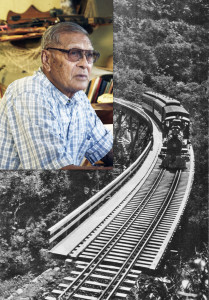276 Haili St
Hilo, HI 96720
USA
 Hawai‘i Island’s remarkable and all-too-brief railway era began on March 28, 1899, with the charter of the Hilo Railroad. Built primarily to meet the transportation needs of the sugar plantations (raw products) and their communities (passengers), the railroad was a standard-gauge, common-carrier system that served much of the island’s east coast. A line connecting the Ola‘a Sugar Mill to Waiākea was completed in 1900, followed by extensions to Kapoho, Hilo town, and Glenwood. A later extension followed the Hāmākua Coast in what was an engineering marvel—with three tunnels, 22 wooden trestles, and 13 steel trestles—and the most expensive railroad in the world for its time. Forced into receivership in 1914, Hilo Railroad emerged as the Hawaii Consolidated Railway and continued moving goods and passengers throughout World War II, including battle-weary American troops en route to Camp Tarawa. Hilo’s devastating tsunami of 1946 caused massive damage to the line, structures, and equipment, signaling the end of an era.
Hawai‘i Island’s remarkable and all-too-brief railway era began on March 28, 1899, with the charter of the Hilo Railroad. Built primarily to meet the transportation needs of the sugar plantations (raw products) and their communities (passengers), the railroad was a standard-gauge, common-carrier system that served much of the island’s east coast. A line connecting the Ola‘a Sugar Mill to Waiākea was completed in 1900, followed by extensions to Kapoho, Hilo town, and Glenwood. A later extension followed the Hāmākua Coast in what was an engineering marvel—with three tunnels, 22 wooden trestles, and 13 steel trestles—and the most expensive railroad in the world for its time. Forced into receivership in 1914, Hilo Railroad emerged as the Hawaii Consolidated Railway and continued moving goods and passengers throughout World War II, including battle-weary American troops en route to Camp Tarawa. Hilo’s devastating tsunami of 1946 caused massive damage to the line, structures, and equipment, signaling the end of an era.
Fortunately for us, one man’s memories of these times and events are still bright. Uncle Roy Wilson grew up in the Ka‘ū district, worked as a trackman on the rail line for Ola‘a Sugar Plantation, and as a brakeman and gandydancer on the Hawaii Consolidated Railway … as such, he was both participant and eyewitness to some of the most formative decades in Hawai‘i’s modern history. Join us for an evening of talk story you won’t soon forget!
Free to Lyman Museum members; $3 nonmembers. Doors open at 6:30 p.m. for evening public programs. Limited seating; first come, first seated. Additional parking next door at Hilo Union School. (Click here to see map of additional parking)

Speak Your Mind